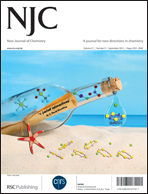A new compound, Rb2Cu3(P2O7)2, has been obtained from the melt in the Rb–Cu–P–O system. Its monoclinic crystal structure was determined by single-crystal X-ray diffraction: space group P21/c, Z = 2, a = 7.7119(8) Å, b = 10.5245(9) Å, c = 7.8034(9) Å, β = 103.862(5)° at 293 K, R = 0.030. The copper ions show coordination number (CN) 6 (4+2, distorted tetragonal bipyramidal). Trimers of [CuO6] polyhedra sharing cis-edges form together with diphosphate groups of two tetrahedra [P2O7] a microporous 3D framework with channels open along the c direction. The rubidium ions positioned in the channels show CN 10. The new phase is isotypic to Cs2Cu3(P2O7)2. The regular changes in cell dimensions in the row Cs2Cu3(P2O7)2 → Rb2Cu3(P2O7)2 are caused by the compression of channel volumes due to decrease of the Cu–O–P angles in the framework windows. An electron spin resonance study indicates appearance of short range magnetic correlations below ∼120 K, long range magnetic order takes place at TN = 9.2 K as follows from magnetization and specific heat measurements. First principles calculations of the magnetic exchanges indicate that the effective Cu–Cu hopping interactions corresponding to super–super-exchange paths involving P atoms are much stronger than those within the edge-sharing Cu2–Cu1–Cu2 trimer units.

You have access to this article
 Please wait while we load your content...
Something went wrong. Try again?
Please wait while we load your content...
Something went wrong. Try again?


 Please wait while we load your content...
Please wait while we load your content...